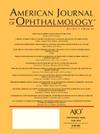1型神经纤维瘤病(NF1)相关的眼部体征:NF1儿童的患病率、发病率和基因型-表型相关性的新见解
IF 4.1
1区 医学
Q1 OPHTHALMOLOGY
引用次数: 0
摘要
目的:在大量受神经纤维瘤病 1 型(NF1)影响的儿科人群中,评估与 NF1 相关的主要眼部体征的患病率、发病率、发病年龄和基因型相关性,包括:视通路胶质瘤(OPG)、利什结节(LNs)、脉络膜异常(CAs)和视网膜血管异常(RVAs):方法:纳入 2010 年至 2022 年期间在我院接受随访的年龄小于 16 岁的 NF1 患者。通过裂隙灯观察(LNs)、近红外(NIR)成像(CAs和RVAs)和神经影像修订(OPG),在基线和随访评估期间评估是否存在与NF1相关的眼部体征。根据基因变异对患者进行分类。其中 204 人接受了至少一次随访,210 人接受了基因检测。基线时,OPG、LN、CA 和 RVA 的发病率分别为 20.7%、43.5%、46.8% 和 6.8%。随访期间的发病率分别为6.4%、22.4%、21.4%和5.4%,平均发病年龄为6.3±3.6岁、7.1±3.0岁、6.4±3.0岁和6.6±2.9岁。与非截断突变患者相比,截断突变患者出现眼部体征的数量更高(1.7±1.0 vs 0.9±0.9,P=.0019):关于儿科患者NF1相关眼部体征的流行率和发病率的数据表明,这些体征在7岁以后似乎可以忽略不计。LNs和CAs似乎是独立发展的,因此可被视为两个独立的诊断标准。截断突变与较多的 NF1 相关眼征表型相关。本文章由计算机程序翻译,如有差异,请以英文原文为准。
Neurofibromatosis Type 1 (NF1)–Related Ocular Signs: New Insights on Their Prevalence, Incidence, and Genotype-Phenotype Correlation in NF1 Children
PURPOSE
To assess, in a large pediatric population affected by neurofibromatosis type 1 (NF1), the prevalence, incidence, age of onset, and genotype correlation of the main NF1-related ocular signs, including optic pathway glioma (OPG), Lisch nodules (LNs), choroidal abnormalities (CAs), and retinal vascular abnormalities (RVAs).
METHODS
NF1 patients ≤16 years old followed at our institution between 2010 and 2022 were included. Presence of NF1-related ocular signs was assessed at baseline and during follow-up evaluations through slit lamp observation (LNs), near-infrared imaging (CAs and RVAs), and neuroimaging revision (OPG). Patients were categorized according to their genetic variant.
RESULTS
A total of 237 patients were enrolled. Among those, 204 underwent at least 1 follow-up and genetic test was available for 210. Prevalence of OPG, LNs, CAs, and RVAs at baseline was, respectively, 20.7%, 43.5%, 46.8%, and 6.8%. Their incidence during follow-up was 6.4%, 22.4%, 21.4%, and 5.4%, respectively, and the mean age at onset was 6.3±3.6, 7.1±3.0, 6.4±3.0, and 6.6±2.9 years. Patients with truncating mutations presented a higher number of ocular signs than those with non-truncating mutations (1.7±1.0 vs 0.9±0.9, P = .0019).
CONCLUSIONS
Data on prevalence and incidence of NF1-related ocular signs in pediatric patients evidences that the development of these signs seems negligible after the age of 7. LNs and CAs seem to develop independently and, therefore, can be considered as two separate diagnostic criteria. Truncating mutations correlate with a higher number of NF1-related ocular signs phenotype. Note: Publication of this article is sponsored by the American Ophthalmological Society.
求助全文
通过发布文献求助,成功后即可免费获取论文全文。
去求助
来源期刊
CiteScore
9.20
自引率
7.10%
发文量
406
审稿时长
36 days
期刊介绍:
The American Journal of Ophthalmology is a peer-reviewed, scientific publication that welcomes the submission of original, previously unpublished manuscripts directed to ophthalmologists and visual science specialists describing clinical investigations, clinical observations, and clinically relevant laboratory investigations. Published monthly since 1884, the full text of the American Journal of Ophthalmology and supplementary material are also presented online at www.AJO.com and on ScienceDirect.
The American Journal of Ophthalmology publishes Full-Length Articles, Perspectives, Editorials, Correspondences, Books Reports and Announcements. Brief Reports and Case Reports are no longer published. We recommend submitting Brief Reports and Case Reports to our companion publication, the American Journal of Ophthalmology Case Reports.
Manuscripts are accepted with the understanding that they have not been and will not be published elsewhere substantially in any format, and that there are no ethical problems with the content or data collection. Authors may be requested to produce the data upon which the manuscript is based and to answer expeditiously any questions about the manuscript or its authors.

 求助内容:
求助内容: 应助结果提醒方式:
应助结果提醒方式:


